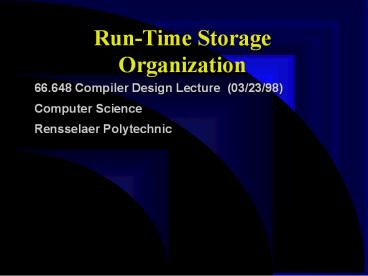Run-Time Storage Organization - PowerPoint PPT Presentation
Title:
Run-Time Storage Organization
Description:
A program obtains a single contiguous block of storage (virtual memory) from the ... The size of this can be determined statically by the compiler/linker. Static Data ... – PowerPoint PPT presentation
Number of Views:2384
Avg rating:3.0/5.0
Title: Run-Time Storage Organization
1
Run-Time Storage Organization
- 66.648 Compiler Design Lecture (03/23/98)
- Computer Science
- Rensselaer Polytechnic
2
Lecture Outline
- Run-Time Storage Organization
- Examples
- Administration
3
Run-Time Storage Organization
- A program obtains a single contiguous block of
storage (virtual memory) from the operating
system at the start of program execution. The
generated code assumes a subdivision of the
storage into different areas/ - Code -- this area contains the generated target
code for all procedures in the program. The size
of this can be determined statically by the
compiler/linker.
4
Static Data
- Static Data-- this area contains global data
objects whose size can be determined statically
at compile time. Static variables are mapped to
offsets in the static data area.
5
Stack
- Stack--runtime stack of activation records
reflecting the stack structure of dynamic
procedure calls and returns. An activation record
contains the information needed by a single
procedure call. Local variables are mapped to
offsets in the activation record.
6
Heap
- Heap -- used to store all other program data
(data that is dynamically sized or data with
lifetime pattern that cannot be represented in
the run-time stack). Heap data allocation incurs
more overhead than static or stack data
allocation.
7
Languages and Storage Organization
- Fortran - Static
- Pascal - Stack/heap
- C Stack/Heap
8
Activation Record
- Public class X
- public static void main(String argsv)
- int n
- n 10
- System.out.println(fib(n))
- int fib(int n)
- if (n0) return 1 else if (n1) return 1 else
return(fib(n-1)fib(n-2))
9
Compile Time Layout of Local Data
- Local variables offsets are calculated depending
on its size. These offsets can be computed
relative to the start of the stack frame, and can
be used to specify the layout of local data in
the stack frame. - Local variables accesses get translated to
negative-valued offsets on the stack pointer.
10
Non-Local Variable
- An access to a lexically scoped nonlocal variable
gets translated to ltlevel-count,frame-offsetgt. - Level-count k indicates that the variable can
be found in the kth enclosing scope.
11
Variable/Field of Unknown Size
- How do we allocate storage for a variable/ field
with statically unknown size e.g. an array or an
adt (abstract Data Type). - By allocating storage separately (on the heap or
on top of the AR on the stack) and storing a
pointer to the storage in the AR.
12
Other Basic Concepts in Runtime Structues
- Call Sequence -- instruction Sequences that
allocates AR for callee procedures and fills in
some of the fields. - Return Sequence- instruction sequence that
restores machine state so that caller procedure
can continue execution. - Lexical scope -- Nonlocal names are resolved via
static nesting. - Dynamic Scope nonlocal names are resolved by
inhering name bindings (following control links)
13
Example
14
Parameter Passing
- Call by value -- caller places r-value for actual
parameter in the storage formal parameter. - Call by reference -- caller places l-value for
actual parameter in the storage for formal
parameter. - Call by value result -- caller places r-value for
the actual parameter in the storage for formal
parameter and also determines the l-value of the
actual parameter. On return, the current r-value
of the formal parameter is copied to the l-value
of the actual parameter.
15
Example
16
Comments and Feedback
- Project 3 is out. Please start working. PLEASE
do not wait for the due date to come. - We are in chapter 8. Please read that chapter and
read the relevant portion of Java. Please keep
studying this material and work exercises.































